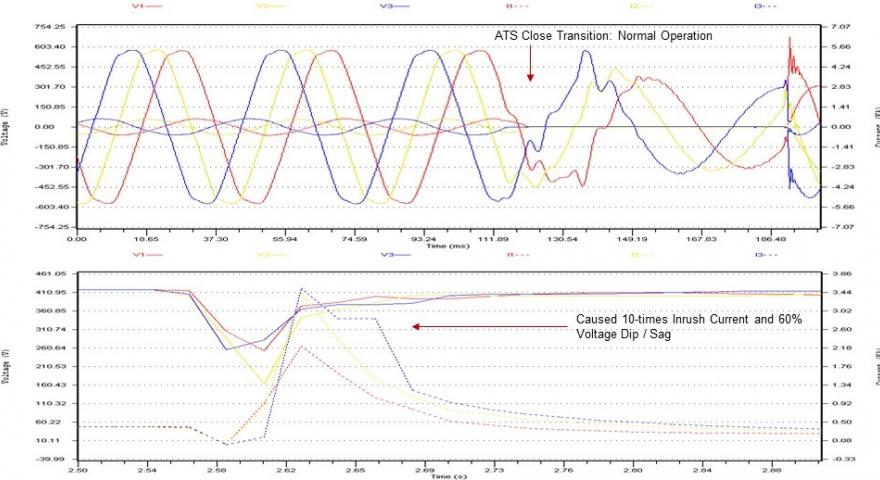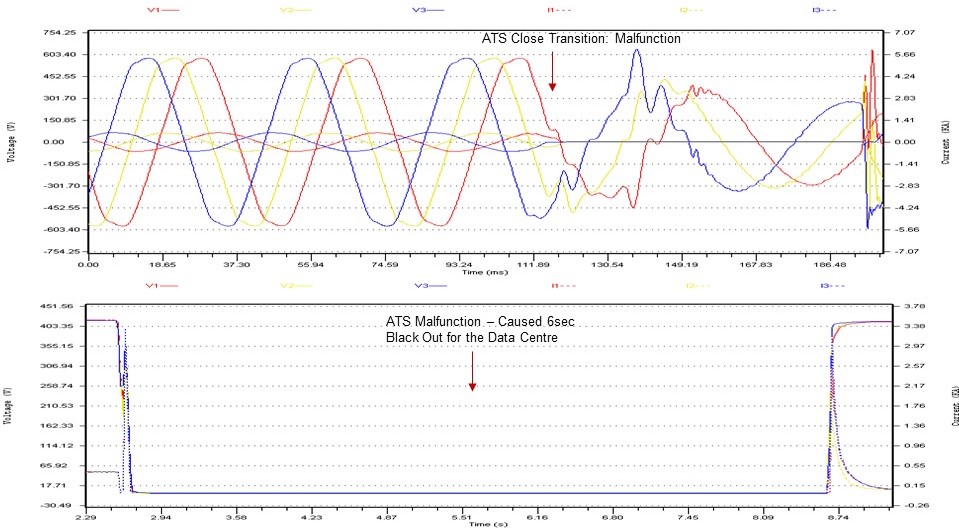
Auto Transfer Switch ATS transitions in Data center: A R&D Telecommunication and POP Internet Company had reported an UNUSUAL PROBLEM of Data Center Blackout, which infrequently, and out-of-the-blue, blacks out its entire data center load. In-addition, it had reported multiple incidents of alternator winding failures with its emergency DG. An inquisitive engineer always wondered why the Auto Transfer Switches are so overdesigned. Well, the answer lies in the "Waveform-and-RMS View" of this case study, as enclosed in the caption picture above.
The Data Center was having an Grid incoming transformer of 1500kva, 11kv/433v for catering exclusively to its Data Center loads which was further backed up by a 1500kva, 415v DG set for emergency in case of Grid supply failures. A 2000A ATS was used for the close transition between the emergency DG and the Grid supply. The actual Data Center load was 350A. From the recorded graph above, it is observed that the duration of a normal close transition is between 70 to 200ms, and it happens at the cost of an impaired, and otherwise, unacceptable power quality, and voltage flickers. Even with its normal close transition, it caused 10-times inrush current from 350A to 3542A, and dragged the system voltage down to a 60% voltage sag, from 417V to 165V. There were instances wherein the resulting current surge and voltage fluctuations had tripped its upstream circuit breaker at the utility company's substation.

The problem, being an infrequent one, remained elusive at first analysis and was required to be studied for a longer time until the root cause found, as enclosed in the "Waveform-and-RMS View" records below. The ATS was though mostly operating normally, was found to be malfunctioning at times, even though it was so hugely overdesigned. The problem occurred when its close transition attempt from emergency DG to Grid supply had failed, and then reverting to emergency DG caused the DG to collapse. Unlike Grid, the DG is a weak power source with a lesser fault level, and can't handle such an impaired quality of power, voltage flickers and current inrush. It could not take back the ATS close transition and collapsed. Thereafter, either the emergency DG recovered or the Grid supply resumed soon, being unmanned recording for a week it could not be verified. The blackout duration here lasted for 6sec., and it did not cause a blackout in the data center.
If the blackout had happened for a shorter time, there would not have been any issue since the Data Centre UPS could have backed it up in the intervening period. But, going by the history of the reported problem, the blackout must have been prolonged, many a times, beyond the UPS battery capacity. Thus, the recording is conclusive on the root cause of the reported problem. DG can't always recover soon, and that's why those long duration black outs had been reported, and the impaired power quality could have burned the alternator winding insulation.


















